Phosphates: Vanadinite
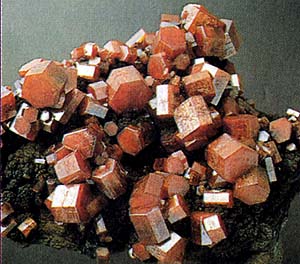 Diagnostic card.
Diagnostic card.
Pb 5 (VO 4 ) 3 Cl
Shingoniya hexagonal
Hardness
Specific weight 6,5-7,1
Cleavage is absent
Fracture brittle, brittle
Color yellow, brown, orange-red
Color in powder light yellow
Shine diamond, greasy

 Vanadinite, - chloride-vanadate of lead. The gloss is oily to diamond, transparent to translucent. Colors: orange to red, less often brown. The line is light yellow. The fracture is uneven. It's fragile. Cleavage is absent. It forms in the oxidation zone of lead deposits. Crystals (hexagonal syngony) are needle-like, small, dense aggregates, clusters are found. The source of the associated production of vanadium. It occurs in the deposits of Carinthia (Austria), Spain, Rhodesia, USA, Mexico.
Vanadinite, - chloride-vanadate of lead. The gloss is oily to diamond, transparent to translucent. Colors: orange to red, less often brown. The line is light yellow. The fracture is uneven. It's fragile. Cleavage is absent. It forms in the oxidation zone of lead deposits. Crystals (hexagonal syngony) are needle-like, small, dense aggregates, clusters are found. The source of the associated production of vanadium. It occurs in the deposits of Carinthia (Austria), Spain, Rhodesia, USA, Mexico.
Vanadinite forms crystals that do not differ in the variety of forms, mostly prismatic or barrel-shaped. Coloring orange-red, brown-red, ruby-red, yellow. Color orange red, ruby red, brownish red in all directions; Also reddish-brown, brown, brownish-yellow, yellow, pale straw-yellow.
Chemical composition - content (in%) :; V2O5-17-19; PbO = 75 - 79; As2O5 3-13; Cl - 2.4 - 2.6; CaO to 3.5. Glitter - polusmolisty to semi-diamond. Shingonia - Hexagonal; Hexagonal-dipyramidal. Cleavage - according to {001} perfect, according to {010} clear. Aggregates - Short-prismatic crystals up to long-prismatic along [0001], usually with smooth faces and sharp edges; Also acicular to hairline. Sometimes cavernous, crystals in the form of hollow prisms; Also in rounded forms and parallel groups, like pyromorphite-mimeset; skeletal; In the form of flattened nodules.

Vanadinitis. Crystals up to 1 cm. Berezovskoye deposit, Cf. Ural, Russia. Photo: © А.А. Evseev.

Vanadinitis. Morocco. Photo: © А.А. Evseev.
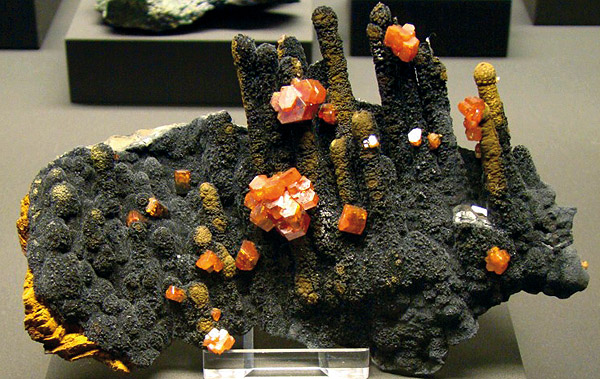
Vanadinitis on goethite. Morocco. (2011).
Diagnostic signs.
Easily melts in the flame; Soluble in nitric acid; If this solution is evaporated, a red precipitate is formed (instead of white, as in the other minerals of this group). Easily melts. In the close. Tr. Cracked and gives an insignificant amount of lead chloride sublimate. Easily soluble in HNO3, forming a yellow solution; Is dissolved in HCl to form a green solution and a lead chloride precipitate.
Origin.
Like pyromorphite or mimetite, vanadinite is a secondary mineral of the oxidation zone of lead deposits; But unlike the first two, it is more rare.
Deposits and applications.
Occurs in the Urals, in Austria, Scotland. Large crystals are mined in the Mibladen deposit in Morocco. Ruby-red and brown-red hexagonal crystals of vanadinite from different deposits in the states of Arizona and New Mexico are known. Vanadinite is used as a vanadium ore.
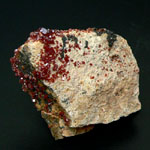
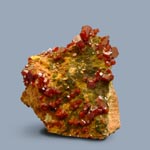
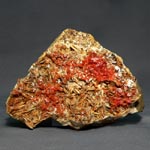
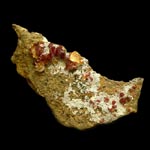
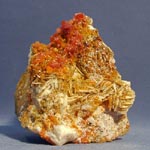
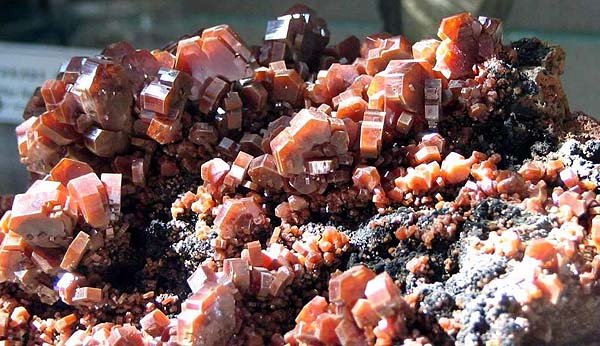
Vanadinitis. Miabladen, Morocco. Crystals up to 2 cm. Photo: © А.А. Evseev.
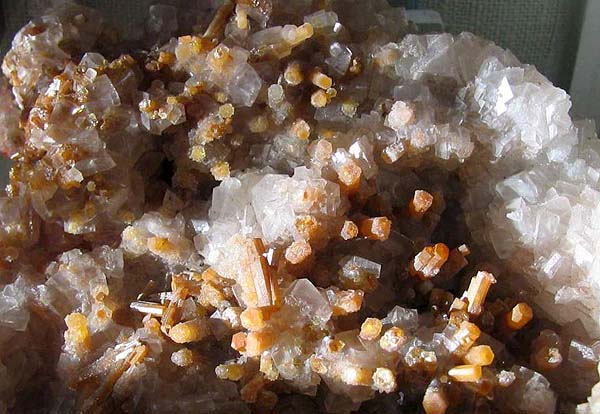
Vanadinitis. Chihuahua, Mexico. Crystals up to 1 cm. Photo: © А.А. Evseev.
In the human body, vanadium participates in oxidation-reduction processes, respiration, hematopoiesis. It plays an important role in the processes of growth and reproduction, and also slows the synthesis of cholesterol, it is necessary for the formation of bone tissue and teeth. The human body contains about 100 μg of vanadium. Absorbed 5% of vanadium, ingested, orally (as vanadyl or vanadate). Vanadium is a part of muscle and bone tissue, can accumulate in the heart muscle, spleen, thyroid, lungs, kidneys. Urine is the main excretion method for absorbed vanadium, and bones are the main place of deposition (content).
The compounds containing vanadium exhibit an antitumor effect. Signs of vanadium deficiency: Vanadium deficiency can be one of the causes of diseases of the cardiovascular system and kidneys, an increased risk of atherosclerosis, an increased risk of developing diabetes, a reduction in reproductive capacity and an increase in infant mortality. When growing goats on a vanadium-depleted diet, there was an increase in the number of miscarriages (late in pregnancy) and mortality among newborn animals. Both biologically active forms of vanadium (vanadate and vanadyl) exhibit insulin action. In fact, all the effects of insulin, aimed at regulating the metabolism of carbohydrates and lipids, are simulated by vanadium compounds.
In acute exposure to toxic doses of vanadium, chemical burns are noted - local inflammatory reactions of the skin and mucous membranes of the eyes, upper respiratory tract, congestion of mucus in the bronchi and alveoli. There are also systemic allergic reactions such as asthma and eczema, as well as leukopenia and anemia. In schizophrenia, the content of vanadium in the blood increases significantly. The main manifestations of excess vanadium: a decrease in the content of ascorbic acid in the body, a decrease in the content of cystine in the hair, an increase in the incidence of bronchopulmonary system diseases, an increase in the risk of developing tumors.
ADR 6.1

Toxic substances (poison)
Risk of poisoning by inhalation, in contact with skin or if swallowed. Dangerous to aquatic environment or sewer system
Use a mask for emergency leaving the vehicle
White diamond, ADR number, black skull and crossbones
| The name of a cargo that is particularly dangerous for transportation | room
UN |
Class
ADR |
| Vanadium catalyst for the production of sulfuric acid | 3288 | 6.1. |
- Ghetchellit - "New Almaden blend" - arsenide and antimony sulfide (modern sulfosol)
- Antimony is a toxic metal (semimetal) , widely used in metallurgy, medicine and engineering
- Zirconium - a rare and undiscovered metal and the most dangerous precious stone in oxide and salt
- Gold - yellow dangerous and poisonous metal of modern accurate digital and cable technologies
- Sulfur is a golden-yellow toxic substance and a sign of active volcanic activity
- Cadmium is an undisputed toxic silvery metal unknown to a wide range of people
- Lead - a toxic gray imitator of metallic silver and toxic metal blende
- Arsenic is a classic poison of medieval and modern poisoners and medicine in medicine
Poisonous and radioactive dangerous stones and minerals
** - poisonous stones and minerals (mandatory check in the chemical laboratory + explicit indication of toxicity)
** - radioactive stones and minerals (mandatory check on the standard dosimeter + ban on open sales in case of radioactivity exceeding 24 milli / g / h + additional measures of population protection)
Catalog of minerals and semi-precious stones of the world by groups
** - poisonous stones and minerals
** - radioactive stones and minerals


Comments
When commenting on, remember that the content and tone of your message can hurt the feelings of real people, show respect and tolerance to your interlocutors even if you do not share their opinion, your behavior in the conditions of freedom of expression and anonymity provided by the Internet, changes Not only virtual, but also the real world. All comments are hidden from the index, spam is controlled.